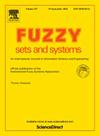具有执行器故障的 IT2 模糊半马尔可夫跃迁系统的非脆弱反过渡-同步容错控制
IF 3.2
1区 数学
Q2 COMPUTER SCIENCE, THEORY & METHODS
引用次数: 0
摘要
本文研究了具有有界停留时间的离散区间 2 型模糊半马尔可夫跃迁系统的非脆弱反过渡同步容错控制。与传统的高木-菅野(Takagi-Sugeno,T-S)模糊模型不同,本文利用区间 2 型模糊模型来表示非线性离散半马尔可夫跳跃系统。其主要创新点是在 IT2 模糊、容错控制和过渡异步的框架下,设计了一种具有控制器增益波动的反过渡异步容错控制机制,在一定程度上降低了保守性。采用过渡异步,即控制器的切换滞后于工厂的切换,这种滞后与当前模式和下一模式之间的转换有关。通过半马尔可夫核方法,实现了底层系统的均方稳定性,克服了过渡异步带来的困难。此外,考虑到执行器在系统运行过程中可能会遇到随机故障,本文在非脆弱反过渡异步控制设计中应用了容错方法,提高了系统的容错能力。最后,一个隧道电路模型验证了所设计控制方法的有效性。本文章由计算机程序翻译,如有差异,请以英文原文为准。
Nonfragile anti-transitional-asynchrony fault tolerant control for IT2 fuzzy semi-Markov jump systems with actuator failures
This paper studies the nonfragile anti-transitional-asynchrony fault tolerant control for discrete interval type-2 fuzzy semi-Markov jump systems with bounded dwell time. In contrast to the traditional Takagi-Sugeno (T-S) fuzzy model, this paper utilises the interval 2-type fuzzy model to represent the nonlinear discrete semi-Markov jump systems. The main novelty is to design an anti-transitional-asynchrony fault-tolerant control mechanism with controller gain fluctuations under the framework of IT2 fuzzy, fault-tolerant control, and transitional asynchrony, which reduces the conservatism to a certain extent. The transitional asynchrony is adopted, i.e., the controller switching lags behind the plant switching, and this lag is associated with the transition between the current mode and the next mode. By virtue of semi-Markov kernel method, the mean-square stability of the underlying system is achieved, overcoming the difficulties caused by the transitional asynchrony. In addition, taking into account that the actuator may encounter random faults during system operation, this paper applies a fault tolerant method in the design of nonfragile anti-transitional-asynchrony control to improve the fault tolerance of the system. Finally, a tunnel circuit model verifies the effectiveness of the designed control method.
求助全文
通过发布文献求助,成功后即可免费获取论文全文。
去求助
来源期刊

Fuzzy Sets and Systems
数学-计算机:理论方法
CiteScore
6.50
自引率
17.90%
发文量
321
审稿时长
6.1 months
期刊介绍:
Since its launching in 1978, the journal Fuzzy Sets and Systems has been devoted to the international advancement of the theory and application of fuzzy sets and systems. The theory of fuzzy sets now encompasses a well organized corpus of basic notions including (and not restricted to) aggregation operations, a generalized theory of relations, specific measures of information content, a calculus of fuzzy numbers. Fuzzy sets are also the cornerstone of a non-additive uncertainty theory, namely possibility theory, and of a versatile tool for both linguistic and numerical modeling: fuzzy rule-based systems. Numerous works now combine fuzzy concepts with other scientific disciplines as well as modern technologies.
In mathematics fuzzy sets have triggered new research topics in connection with category theory, topology, algebra, analysis. Fuzzy sets are also part of a recent trend in the study of generalized measures and integrals, and are combined with statistical methods. Furthermore, fuzzy sets have strong logical underpinnings in the tradition of many-valued logics.
 求助内容:
求助内容: 应助结果提醒方式:
应助结果提醒方式:


